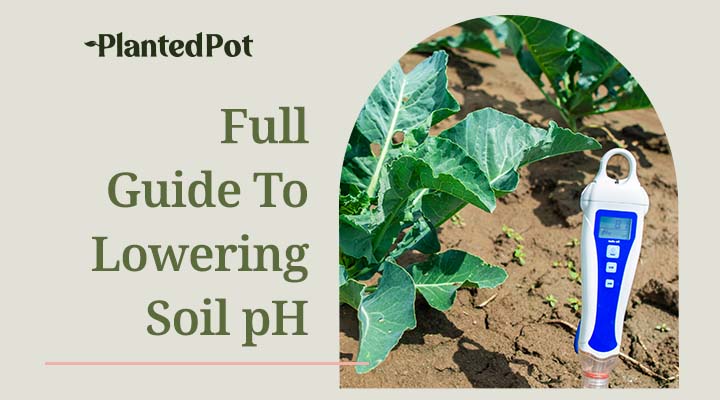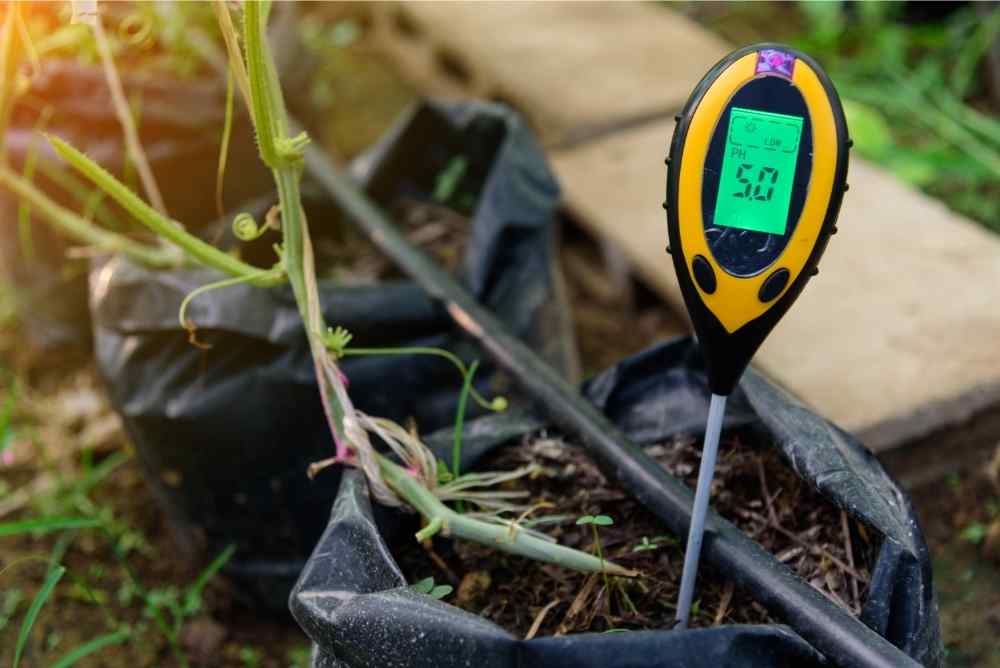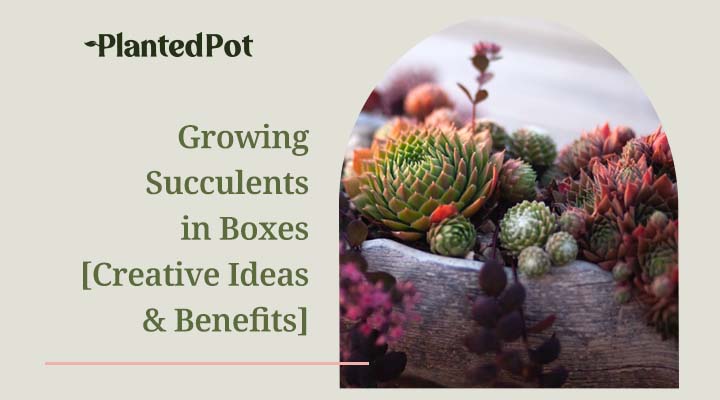
How to Lower Soil pH: Keeping Your Plants Healthy & Strong!
Home / How to Lower Soil pH: Keeping Your Plants Healthy & Strong!

How to Lower Soil pH: Keeping Your Plants Healthy & Strong!
Learning how to lower soil pH is an important skill to have when it comes to growing plants! Plants thrive in slightly more acidic soil, and if the pH of the soil is too high, it may lead to plant poisoning and even death. Minerals and nutrients tend to be more abundant in acidic soil, making it better for overall plant health.
If you came looking for answers, you came to the right place! This article will discuss what changes a soil pH level and how to correct highly alkaline earth that keeps ruining your beautiful garden.
What is pH?
pH stands for “potential hydrogen,” which refers to the amount of hydrogen present in any particular substance. The amount of hydrogen affects levels of acidity and alkalinity, which are terms that describe the nature of reactivity something has. If something is acidic, then it reacts strongly to alkaline (or “basic”) substances, and vice versa; if something is basic (alkaline), it will react strongly to something acidic.
There’s a pH scale for almost anything you can think of! The acidity and alkalinity are typically measured using the pH scale that ranges from 0-14. Here’s how the scale is laid out:
- 0-7 = acidic
- 7 = neutral
- 7-14 = alkaline (basic)
Sweet & Sour Soil
When soil is acidic, it’s called “sour” soil and contains lots of hydrogen molecules. Sour soil will range anywhere from 0-5 on the pH scale. Alkaline soils are “sweet” and will be rich in calcium, sodium, and magnesium. This kind of soil will range anywhere from 8-14 on the pH scale.
Testing pH Levels
Electronic oil test kits make measuring pH of your soil fairly easily. They come with a probe that you dip into muddied water in your garden and provide a pH number on a screen or point to a number along with a gauge. Anytime you test your soil, you should use distilled water, or you may get false results. Tap or drinking water has contaminants that can alter the alkalinity of the water and produce a false reading.
Some test kits use capsules filled with powder or strips of paper coated in chemicals that react with the chemistry of the soil to indicate its acidity/alkaline levels. These strips reference a gradient of colors that relate to pH numbers based on the shade the test strip turns when it comes into contact with a reactive agent mixed into a soil sample.
To ensure accuracy, take dirt from 3 to 4 different parts of your garden to get an inclusive sample of the whole area. Not every part of your garden will necessarily have the same pH level, which means you may change where you plant certain foliage or what treatments you apply to correct pH levels. A soil test should be performed every 2-3 years as environmental conditions can change the pH of the soil.
DIY Cabbage Method
If you have some spare red cabbage in your refrigerator you don’t plan on eating (or if you love boiled red cabbage and want to eat it later, no judging), it can help you measure soil pH in a simple test using distilled water, red cabbage, and a bit of garden soil.
- Chop the cabbage into small pieces.
- Boil the cabbage in distilled water (again, because it has a neutral pH) for about 10 minutes or until the water turns violet.
- Once water is violet, remove the pot from the stove, strain out the cabbage, and set it aside.
- Pour some of the boiled water (still hot) into a separate bowl.
- Add a spoonful of your soil to the bowl and watch for color changes.
If the water turns pink after you add the soil, that means it’s acidic. A blue-green color means it is alkaline, and no change means it is neutral. The deeper the shade is, the more acidic or alkaline it is!

What is pH in soil?
Plants usually prefer acidic (sour), alkaline (sweet), or neutral pH soils. Planting something in unfavorable conditions may cause the plant to struggle for survival or to die altogether.
The average garden has pH scale ranges from 3.5 – 8. Of course, these numbers will vary depending on geography and other factors. Areas with higher rainfall will see values between 5 – 7, and drier areas will be around 6.5 – 9. In California, soil tends to be more acidic in the 5 – 8.5 range, though this changes in highly occupied or industrial areas.
Soil Formation
The natural components of soil include dead leaves and branches and “parent material,” which is the starting point for all soil production. Soil inherits properties from parent material composition, usually made from mineral rock like granite or limestone and decomposed organic matter. Parent material greatly affects the fertility and chemistry of the soil. This, in combination with other natural processes, help form soil:
- Organisms: Insects, animals, people, and microorganisms that change the land by eating plants, walking, building on top of, and otherwise altering the earth in physical and chemical ways.
- Climate: Rain, wind, sun, and other weathering factors that cause erosion.
- Relief: The elevation of land which influences water drainage and weathering rate.
- Time: The above factors need time to effectively develop rich and fertile soils.
Why is pH Important in Soil?
Plants need three main nutrients from the soil to grow: nitrogen, phosphorus, and potassium. The acidity or alkalinity of the soil affects how easily a plant can absorb these vital nutrients. A pH level between 6.5 and 7 is best for garden plants to thrive.
Nutrient Availability
The pH levels in soil affect the solubility of nutrients and chemicals in soil water, or the water that moves through dirt to bring nutrients to plant roots. This means that available nutrients for plant intake are affected when the soil is too acidic or too basic. Some nutrients are more abundant in acidic soils, while others are more abundant in alkaline soils.
These pH levels also affect the activity of healthy microorganisms in the soil that break down organic material and transforming it into fertilizing material. Having the right soil pH conditions affects many different factors in the health of your garden.
What Factors Affect Soil pH?
Numerous natural factors contribute to the pH of soil! Here are a few of the main ones:
- Climate and weather: Temperature and rainfall frequency influence the rate at which water-soluble plant nutrients are retained or lost. In warmer climates, soil pH decreases and increases in drier climates.
- Mineral content: The composition of the parent material changes depending on its content. For instance, if it is made of limestone, the soil formation that develops on top will likely be alkaline. You ca
- Soil texture: The density of soil affects a soil’s resistance to pH changes. Soil mixed with lots of clay are more resistant than looser sandy soils and allows for more percolation and a low buffering capacity. Water and other pH-altering substances can easily penetrate looser soils.
- Organic matter decay: Decaying organic matter emits hydrogen as it rots, which causes acidity, though this may take years of accumulation to cause a change.
- Crop harvest: High-yielding crops like wheat and squash quickly absorb basic materials from the soil to grow. Because they are grown in high volume and are continuously cultivated, they take the alkalinity from the soil they are grown in, leaving the remaining earth acidic.
- Fertilizers: Many fertilizers utilize nitrogen which can cause acidity if it comes into contact with ammonium and turns into nitrite.
- Wildfires: Fire burns away vegetation which contributes to nutrient availability, and the fire itself eliminates nitrogen to make the soil acidic.
How to Lower Soil pH
If your soil pH is too high, don’t worry! There are easy and natural ways to lower the alkalinity.
Chemical Compounds
Adding aluminum sulfate will increase the acidity of the soil and decrease pH levels immediately upon application. Elemental sulfur works the same way, but it can take weeks to months of treatment before you see any results. It also requires heat to work well, so it’s usually better for springtime application. Both of these compounds can be found in gardening stores.
Mulch
Pine needles and maple leaves naturally release carbon dioxide when they decompose. Mixing mulch containing organic plant materials like these into the top 12 inches of soil can cause slight changes in pH but is very slow acting. It is recommended you use a chemical agent alongside mulch to see more rapid results.

Compost
Adding compost that has been well-decomposed is a natural and highly beneficial way to lower your high initial soil pH. Compost gradually lowers alkalinity and boosts the health of your plants by improving soil structure and introducing helpful microorganisms to your garden.
Coffee Grounds
Sprinkling your used coffee grounds can also be a huge help. As the grounds break down, they will contribute to the acidity of your soil, effectively lowering soil pH.
What Naturally Lowers pH in soil?
Organic materials like mulch and compost are natural and highly beneficial ways to reduce soil pH without chemical treatments. Though these treatments work slowly over time with consistent application, they are a more permanent solution to maintaining healthy soil pH.
Why Is My Soil pH so High?
High pH indicates you have high levels of hydrogen ions in your soil. This can be caused by natural issues stemming from environmental conditions like parent material, frequency of rainfall, wildfires, or neighboring plants that absorb nutrients other plants need to survive. Whatever the case, almost every gardener has to deal with unideal pH conditions in their gardens.
Simple Tips to Maintain Soil pH
Once your soil has reached an ideal pH, how do you keep it there?
- Better watering practices: Hose and house water have hard water deposits high in pH, which can alter the pH in your soil. Collecting rainwater or irrigating from a natural source is best to water your garden from a cleaner reservoir.
- Consistent treatment: Applying mulch and compost will help control changes in pH and ensure soil conditions stay healthy.
- Test often: Testing soil pH every few months will help you keep track of any changes so that you can apply treatments accordingly and fix issues before they start.
Final Thoughts – How to Lower Soil pH
Gardening doesn’t have to be scary once you know a little bit of science! Soil pH is a measure of how alkaline or acidic your soil is. This affects growing conditions for plants and their ability to thrive in their environment. Things like soil formation and environmental influences like climate, altitude, and soil texture are all factors that contribute to the composition of soil pH.
You can decrease soil pH with natural treatments like mulch and compost or chemical compounds like aluminum sulfate. Consistent pH testing is key to maintaining good soil health and having a happy, healthy garden!



